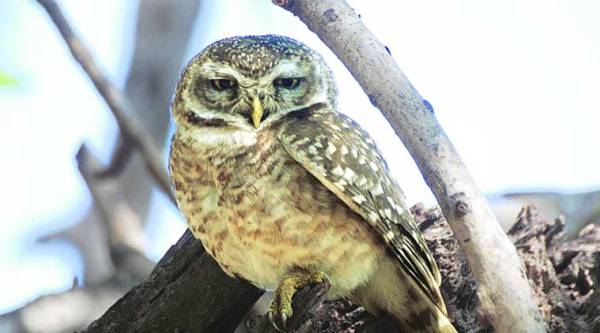Survival Woes: A tale of two owls and why one thrives
But the forest owlet is diurnal and that would not work in the city — at the best of times, owls are heckled and mobbed by other birds, which is why they hunt at night.
 It must be a tough life for this tenacious little owl (Source: Ranjit Lal)
It must be a tough life for this tenacious little owl (Source: Ranjit Lal)
For one, it’s the best of times, for the other, the worst. Yet, both are similar — small, dumpy, round-headed, golden-eyed owlets, dressed in beige-brown plumage marked in white. One has icing sugar spots on its head, the other doesn’t. Both have fairly similar diets — frogs, insects, rats, lizards, and the like. One is so common, it’s considered a species of “least concern”, the other, like a patient in the ICU, is “critically endangered” and indeed, had disappeared from sight for over a 100 years. I have seen and photographed one species outside my bedroom window, and haven’t ever set my eyes on the other. Welcome to the spotted owlet and its cousin, the forest owlet.
It makes you wonder why. Why is the forest owlet — that was recently spotted in Madhya Pradesh and lives in forests in Maharashtra — so rare (world population estimated around 250), while its similar looking cousin (though now considered not as closely related), the spotted owlet so common? Is it because one remains a hidebound country bumpkin, unwilling to change its habits, while the other has turned city slicker and fast food junkie? Is the forest owlet such a stubborn little so-and-so that it would rather stay on in its beloved dry deciduous forests — no matter how degraded they are, and how ruthlessly they’re being hacked down — and die out, than move into the wicked, cacophonous city and shed its dignity by perching on buzzing tubelights, snapping up moths and bluebottles for a living like the spotted owlet does?
It must be a tough life for this tenacious little owl: first, it must find a partner, not easy when there are just around 125 of the opposite sex left in the entire world (and not all your type). Next, a suitable home — a hollow in a tree — must be found, again not easy as the forests it dwells in are ravaged and trees brought down, wholesale. And finally, it must be able to find enough food to be able to raise a brood, again difficult because the undergrowth — where lizards and frogs and rats and other delicious creatures lurk — is being bulldozed. To top it all, the little forest owlet and its young are hunted because of superstition and black magic beliefs. In spite of these odds, it has hung on, and you must remember it has been considered a rarity right since the late 1800s, when it was first discovered (in 1873, to be specific). You can only admire how it has stuck fast to its principles and lifestyle all these years: rather like those few — maybe just 250 — principled people who will not take or give a bribe to get their work done, no matter what the consequences.
Perhaps, it might have been better and certainly easier if it had “gone with the flow” and adapted to big city life like the spotted owlet has done. But the forest owlet is diurnal and that would not work in the city — at the best of times, owls are heckled and mobbed by other birds, which is why they hunt at night. Emerging in daylight in a city, with its crow and myna mobs, and babbler gangs — it wouldn’t stand a chance. Not to mention what we would do to it. So big deal, it could adapt and become like the others — and hunt at night.
But then again, it has the right to live its life the way it wants to, provided it doesn’t infringe too much on the rights of others. Like we do.
Ranjit Lal is an author, environmentalist and bird watcher
E-mail author: ranjitlal55@gmail.com



- 01
- 02
- 03
- 04
- 05
























